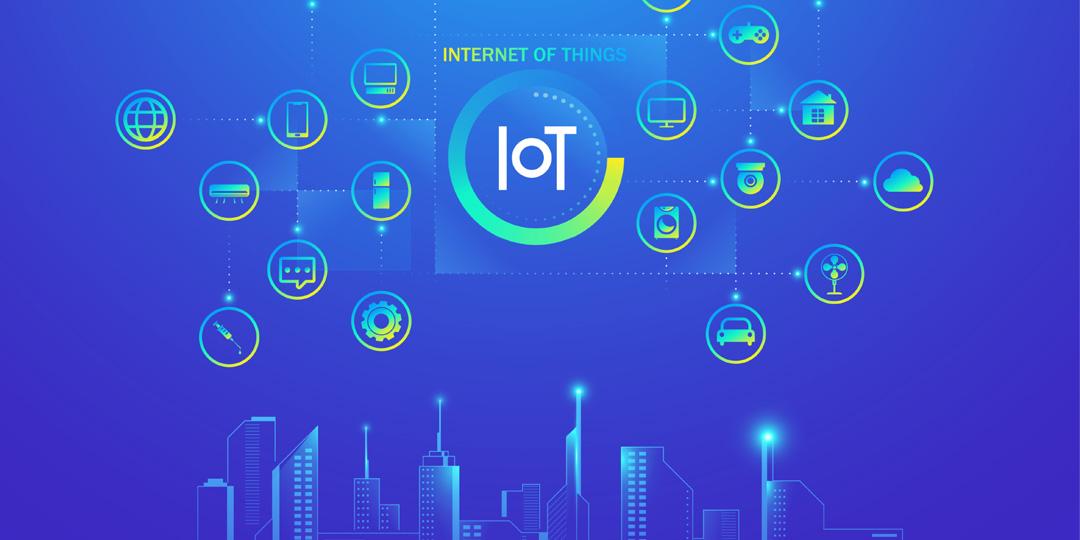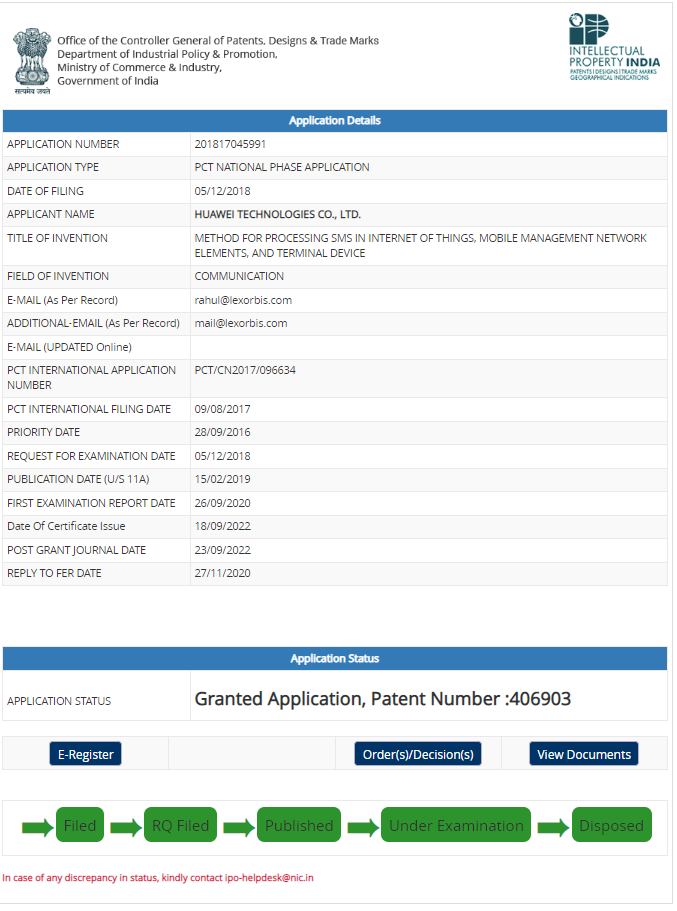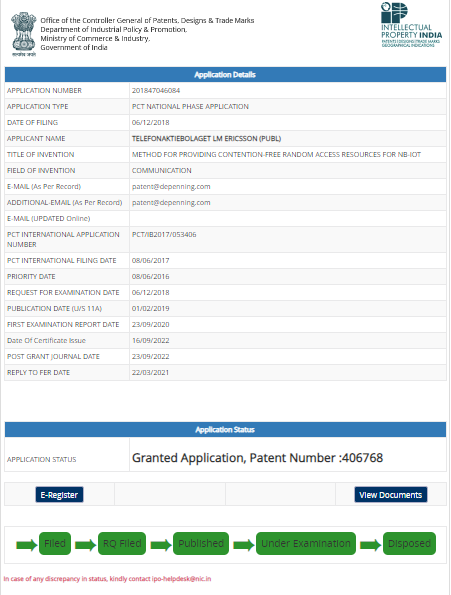PATENT PROTECTION FOR COMPUTER RELATED INVENTIONS (CRIs) IN INTERNET OF THINGS (IOT)

Saranya K
Associate – Intellectual Property Rights Practice
INTRODUCTION
Iot enables physical devices, vehicles, buildings, and other items that have embedded sensors and software that allow them to collect and exchange data with each other over the internet. This technology enables machines to communicate with each other, exchange data and perform actions without any human intervention. IoT cab be called as Internet of Everything (IOE). This term refers to the concept that not only physical objects or devices, but also people, processes, and data are interconnected and communicate through the internet. IoT has the potential to revolutionize various industries, including healthcare, transportation, manufacturing, and others, by improving efficiency, reducing costs, and enhancing productivity. It also has significant implications for privacy, security, and ethics, as the data generated by IoT devices can be highly sensitive and require secure management and protection. [1]
ROLE OF INTELLECTUAL PROPERTY (IP) IN IoT
One of the primary areas of intellectual property in IoT is the design of IoT devices. Manufacturers invest a significant amount of time and money into designing smart devices that are both functional and visually appealing. Intellectual property laws can help protect these designs and ensure that manufacturers have the right to control their use and distribution. One of the primary areas of intellectual property in IoT is the design of IoT devices. Manufacturers invest a significant amount of time and money into designing smart devices that are both functional and visually appealing. Intellectual property laws can help protect these designs and ensure that manufacturers have the right to control their use and distribution.
Companies need to be proactive in protecting their inventions and maintaining their market dominance, which requires a multifaceted approach covering legal, technologies, marketing, and strategic considerations.
Therefore, patenting in such a profitable industry can be very valuable and IoT will also play an important role in industries such as healthcare, smart home/automation smart city, automotive and manufacturing, energy management, security, metaverse, space systems, and more.[2]
PATENTS IN IOT
At present, in order to provide better services, most of the devices are required to be connected through the help of standard technologies.
Many companies may patent standard technologies to ensure that they have exclusive ownership and control over the technology, which can help them prevent competitors from copying or using the technology without permission.
These patents will play a crucial role in invention and technology promotion and will encourage inventors or owners to take innovative steps in IoT developments.[3]
PATENTING IOT IN INDIA
In India, patent applications for the Internet of Things (Iot) can be filed with the Indian Patent Office (IPO) under the Patents Act of 1970. To be eligible for a patent, the invention must be novel, non-obvious, and have industrial applicability.
The IoT industry includes various fields such as sensor technology, wireless communications, cloud computing, data analytics, and cybersecurity. These fields use various software technologies to transmit and share data over the network. Patenting these software technologies is difficult. [4]
SOFTWARE PATENTING IN INDIA
According to patent act 1970, Section 3(k) of the Indian Patent Act excludes ‘mathematical or business methods or computer programs per se or algorithms’ from patentability. In simple words, software per se, mathematical or business methods, and algorithms are not eligible for patent protection under the Indian patent law.
However, inventions that have a practical application of the software or algorithm can be patented in India. The invention should not be simply a computer program but should have technical advancement and innovation with respect to the existing technology. Therefore, computer programs used for implementing a process or apparatus in industries such as healthcare, finance, telecommunications, etc., can be patented.[5]
In particular, the Patent Office has issued guidelines for the examination of CRIs, which clarify that software per se is not patentable in India. However, software which has technical applications beyond mere computerization or automation of processes may be patentable, provided that it meets the other patentability criteria such as novelty, inventive step, and industrial application.
Computer programs are often stated as method statements or system statements, with some “means” indicating the functions of flowcharts or process steps. Algorithm-related statements are even broader than self-declared computer programs, because a single algorithm can be implemented by different programs in different computer languages. . In essence, if claims of any kind such as methods/processes, apparatus/systems/devices, computer program products/computer-readable media, fall under the following categories: excluded categories, they will not be patented.
In the context of IoT, patent protection can be sought for various aspects such as hardware design, firmware, communication protocols, middleware, data analytics algorithms, and user interfaces. In many cases, the value of an IoT solution lies not just in the individual components, but in the integrated system that provides a unique functionality or service.
For example, a patent for a smart agricultural system which uses sensor data to optimize irrigation, fertilizer and pesticide application, and crop management. The patent includes the hardware components comprising sensors and controllers, the firmware that enables the communication and coordination of these components, and the data analytics algorithms that process the sensor data and provide recommendations to the farmer.[6]
Similarly, a patent for a wearable health device which monitors various physiological parameters and provides personalized health recommendations. The patent includes the hardware components comprising sensors and transmitters, the firmware that enables the communication and processing of data, and the algorithms that interpret the data and provide actionable insights to the user.
Patent protection for CRIs will become increasingly important. The Indian Patent Office has taken several steps to provide greater clarity and guidance in this regard, and stakeholders should take advantage of these developments to obtain robust patent protection for their IoT.
COMPUTER RELATED INVENTIONS (CRI)
Computer-related inventions (CRIs) include inventions that involve the use of computers, computer networks, or other programmable devices and include such inventions that one or more features Their functions are realized in whole or in part by one or more computer programs.
Major patent offices around the world are facing questions about CRI’s patentability. They have developed test guides/manuals for examining patent applications in these technology areas in order to standardize testing practices.
GUIDELINES FOR EXAMINATION OF CRI
The procedure for examining an CRI-related patent application is the same as for other patents in relation to the examination of novelty, inventive step, industrial applicability and degree of disclosure, etc.
1.1 Novelty:
Novelty is a key requirement for determining the patentability of any invention.
The invention should be new, novel, and non-obvious,
No invention can be patentable if the enclosed matter as described was disclosed to the public before the date of filing, or before the date of priority.
Before filing for a patent, ensure that your invention is unique and different from other existing solutions. Conduct a thorough search to identify prior art, which refers to information about previous inventions that have been publicly disclosed.
In respect of CRIs, the inventions must contain the combination of both hardware and software.
1.2 Inventive Step:
The level of inventiveness is determined according to the provisions of Section 2(1)(ja) of the Indian Patent Act 1970.
For the purposes of 2(1)(ja), “level of inventiveness” means the feature of the invention relating to technical progress relative to existing knowledge or of economic importance, or both, and make the invention unclear to an art connoisseur.
According to the foregoing, a CRI-based invention must provide a technical improvement or advance in order to make the invention non-obvious.
1.3 Industrial Application:
In patent law, it has been defined in section 2(1) (ac) of Indian Patents Act, 1970 as follows:
“Capable of industrial application”, in relation to an invention, means that the invention is capable of being made or used in an industry,
According to the section mentioned above, the invention must be obvious and used on somewhere. If an invention is not operable, then the invention is not industrially applicable. The invention must disclose a practical application and industrial use.
1.4 Sufficiency of Disclosure:
The Patents Act, 1970 requires the applicant to specify “what is the invention” and “how to perform it” and “how to make it”, and “how to use it”. The invention shall be described fully and particularly to satisfy the requirements.
Provide a detailed and accurate description of the invention in the patent application. This should include specifications, drawings, and any other necessary information that would help someone skilled in the art to understand and reproduce the invention.
The description must be complete, clear, true, accurate and sufficient. It must not contain any statements that are likely to mislead someone knowledgeable in the technical area in which the specification is addressed. Although full disclosure requirements are generally considered in all patent fields.
For a CRI in IoT, it is important to focus on the technical aspects of the invention rather than on the business or functional aspects. This means emphasizing the technical details of the invention such as algorithms or hardware components, and these requirements are considered as fulfilled if the specification addresses the following:
1.4.1 Description of the patent application
- Software patent applications filed in India must require innovative methods, including all stages of software application diagrams, as well as new hardware requirements (requirements) device/system requirements), which include elements of the system architecture that incorporate the respective methods/processes.
- In hardware claims, the working relationship of different components together with the connectivity shall be clear and completely described.
- The outcome or desired outcome of the invention as proposed in the specification and any applicable components/intermediaries shall be clearly described.
1.4.2 Claims
- The claim must clearly define the scope of the invention and must take into account the requirements for patentability as defined in Section 10(5) of the Patent Act 1970.
- According to the CRI based inventions, the claims must include process claim and system/device/apparatus claim.
- A claim filed in a CRI must include the steps involved in the invention and the device or system used to operate a process, i.e. independent claims may be followed by claims. Additional requirements define the different steps of the invention. On the other hand, a dependent claim can be defined as a claim that explains the operation of the invention in detail.
1.4.3 Mean plus Function
The “mean plus function” is a patent claim style that is commonly used in computer related invention. It allows the inventor to claim the board range of functional equivalents of the invention, rather than claiming specific embodiments.
The mean plus function (MPF) claim plays a crucial role in CRI (Computer Related Inventions) inventions as it defines an algorithm or a program that performs a specific task. It is a method or a process that involves the use of hardware and software components.
In patent applications, the MPF claim is used to describe the specific steps or procedures that the software algorithm takes to carry out a particular task or function. This claim helps in protecting the novel and non-obvious aspects of the invention.
The MPF claim is also important for patent litigation as it helps in determining the scope of the patent protection. It defines the specific aspect of the invention that is protected and how it is different from the prior art.
Therefore, MPF claims are an essential part of CRI inventions and it helps inventors to secure their innovations and maintain their competitive edge. When drafting software patents and drafting patent claims, it is common to use media plus function claims. In particular, when drafting a patent claim, a means-plus-function claim may be used to express technical and functional terms of the invention to describe some aspect of the invention.
To avoid the requirement of sec. 3(k), it is necessary to show that the hardware is an essential part of the invention along with the computer software or program.
Keep in mind that obtaining a patent for CRI in IoT can be a lengthy and complex process, but investing time and effort in preparing a solid patent application can help protect development. your intelligence and ensure you have a competitive edge in the marketplace. [7]
IOT PATENT IN INDIA
CASE 1:
HUAWEI TECHNOLOGIES CO., LTD. has filed a patent application in India numbered 201817045991 claiming a “METHOD FOR PROCESSING SMS IN INTERNET OF THINGS, MOBILE MANAGEMENT NETWORK ELEMENTS, AND TERMINAL DEVICE”. The method comprises: a packet switched (PS) domain mobile management network element receives a non-combined registration request from a terminal device, the non-combined registration request being used for implementing registration in a PS domain on the terminal device and carrying SMS indication information; when determining that it is impossible to transfer an SMS to the terminal device over the PS domain, the PS domain mobile management network element sends a location update request to a circuit switched (CS) domain mobile management network element, request to update the location being used to implement the registration in the CS domain on the terminal.

First Examination report was issued by the Indian Patent office for this patent application on September 26, 2020. There is no objection under Section 3 (k) of the Indian Patent Act, but the invention as in claims 1-24 does not involve an inventive step in the light of documents cited below w.r.t. Sec. 2(1) (ja) of The Patents Act, 1970.
In accordance with the discussion during the Hearing, the Applicant respectfully disagrees with the Controller and submits that the amended claims are inventive over the cited documents. The Applicant respectfully submits that the cited documents, D1-D3 do not disclose the features as claimed in amended claims of the invention.
Thus, the application is found to be in order for grant and hence, controller proceed with the grant of a patent to the application no. 201817045991 on September 9, 2022.
CASE 2:
TELEFONAKTIEBOLAGET LM ERICSSON (PUBL) has filed a patent application in India numbered 201847046084 claiming a “METHOD FOR PROVIDING CONTENTION-FREE RANDOM ACCESS RESOURCES FOR NB-IOT”.
The method includes:
- reserving (804) within a Narrowband Physical Random Access Channel (NPRACH) resource (305 405 505 605 705) comprising a plurality of start subcarriers a subset of the plurality of start subcarriers for performing a contention-free random access procedure (310 410 520 530 610 720 730).
- communicating (804) to one or more user equipment (UEs) (110) information indicating which of the plurality of start subcarriers within the NPRACH resource are reserved for performing the contention-free random access procedure.

First Examination report was issued by the Indian Patent office for this patent application on September 23, 2020. There is no objection under Section 3 (k) of the Indian Patent Act, but the invention as in claims 1-32 does not involve an inventive step in the light of documents cited below w.r.t. Sec. 2(1)(ja) of The Patents Act, 1970.
In accordance with the discussion during the Hearing, the Applicant respectfully disagrees with the Controller and submits that the amended claims are inventive over the cited documents. The Applicant respectfully submits that the cited documents do not disclose the features as claimed in amended claims of the invention.
Thus, the application is found to be in order for grant and hence, controller proceed with the grant of a patent to the application no. 201847046084 on September 23, 2022.
CONCLUSION
In conclusion, patenting CRI in IoT technology is crucial in protecting the innovative features and technologies developed by individuals and companies. As the IoT industry continues to grow and expand, there is a need for effective protection of intellectual property rights. The Indian patent office (IPO) has issued guidelines to assist patent examiners in assessing whether a CRI is patentable. The guidelines clarify that a CRI that is more than just a computer program can be patentable if it exhibits technical advancements and solves a technical problem. Therefore, if a CRI related to the IoT in India satisfies the patentability criteria specified by the IPO, it can be protected by patents. This can enable inventors to legally safeguard their technology and prevent their competitors from using, making or selling their inventions without permission.
Overall, patenting CRIs is an important aspect of fostering innovation and development in the IoT industry.
REFERENCES:
[1] https://www.lexology.com/library/detail.aspx?g=8e60c798-09de-4b7a-a65e-84e7a06cbdd7.
[4] https://www.mondaq.com/india/patent/1151018/patenting-computer-software-in-india-an-analysis.
[7] https://www.lexcampus.in/patentability-of-computer-related-inventions/.



